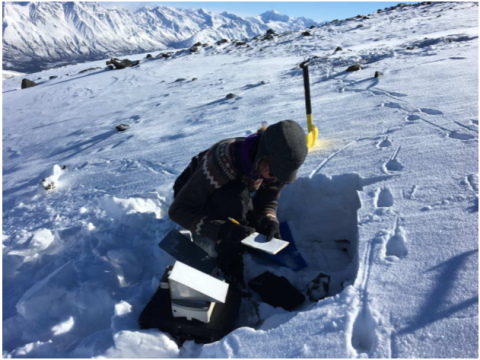Global climate change is driving changes in alpine vegetation and snowpack, and these changes interact with one another. Shrub encroachment reduces habitat area and connectivity and may bring predators closer to sheep. Changes in timing of alpine plant green-up and productivity affect lambing rates and body condition. Sheep rely on alpine meadows with shallow snow and may be severely impacted by deep snow, icing events, and late spring extent. A better understanding of environmental change in alpine systems and impacts on Dall sheep is needed to predict how sheep populations and harvest opportunities are changing throughout their range. This knowledge is critical for wildlife managers, hunters, and other stakeholders to effectively manage this iconic northern species. See Sivy et al., 2018.
ABoVE: Dall Sheep Track Sinking Depths, Snow Depth, Hardness, and Density, 2017
This dataset provides Dall sheep (Ovis dalli dalli) hoof sinking depths in snow tracks, and snow depth, hardness, and density measurements in snow pits adjacent to the tracks. Snow measurements were collected between March 19-22, 2017 at sites on Jaeger Mesa in the Wrangell Mountains (WRST), Alaska. Estimated sheep age classes and track site coordinates are also provided.
Related Publication:
Sivy, Kelly J., Anne W. Nolin, Christopher L. Cosgrove, and Laura R. Prugh. 2018. Critical snow density threshold for Dall sheep (Ovis dalli dalli), Canadian Journal of Zoology, https://doi.org/10.1139/cjz-2017-0259
Data Citation:
Sivy, K.J., A.W. Nolin, C.L. Cosgrove, and L.R. Prugh. 2018. ABoVE: Dall Sheep Track Sinking Depths, Snow Depth, Hardness, and Density, 2017. ORNL DAAC, Oak Ridge, Tennessee, USA. https://doi.org/10.3334/ORNLDAAC/1583
Data center: ORNL DAAC
Sponsor: NASA EOSDIS


